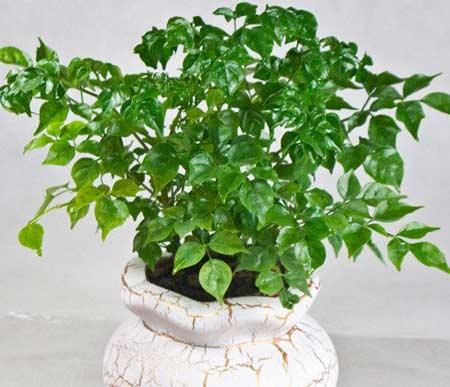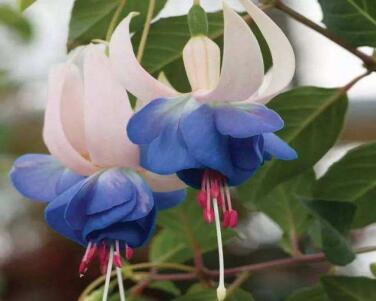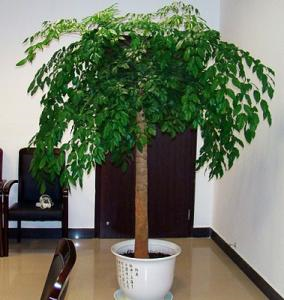Maintenance methods and matters needing attention of Happiness Tree
1. Temperature
Happy trees like the warm environment, the most suitable temperature for growth is 20 degrees to 30 degrees, so we should pay attention to temperature control.
2. Lighting
Happiness trees like plenty of light, of course, summer should pay attention to moderate light, it is best to place on the balcony or windowsill.
3. Watering
The happiness tree needs enough water to grow, and the soil must be kept moist during the growing period. When watering in summer, we should not only water the roots, but also spray the leaves, and reduce watering in winter, so as to avoid root rot.
4. Soil
The soil of the happiness tree is required to be loose, fertile and well drained, which is conducive to the growth of the happiness tree.
5. Fertilization
Fertilization depends on the situation. Fertilizer is usually applied once a month during the growing period, but it should be stopped when the temperature is too high or too low.
6. Disease and pest control
In order to prevent the happiness tree from becoming infected with the virus, it is best to breed it in a ventilated and transparent place. If diseased branches are found, they should be removed in time, and if pests are found, insecticide should be sprayed immediately.

The above is the content of the editor today. I hope the content of the editor can improve the help to the lovers of the Happiness Tree. Thank you for your reading!
The cultivation methods and matters needing attention of Happiness Tree what to do about the fallen leaves of Happiness Tree
The happiness tree means happiness, peace, luxuriant branches and leaves, and the leaves are small and green, which is very ornamental. Then how to raise the happiness tree? Let's learn about the cultivation methods and matters needing attention of the happiness tree, as well as what to do about the fallen leaves of the happiness tree that we are most concerned about.
The cultivation method of Happiness Tree
1. Temperature
Happy trees like a warm environment. The suitable temperature for growth is 20 ℃-21 ℃ in daytime and 18 ℃-19 ℃ at night, and the temperature should be controlled below 27 ℃ in midsummer. When the ambient temperature is very high, it is necessary to build a shed for shade. To increase the humidity of the environment and leaves, it is best to maintain a greenhouse temperature of not less than 8 ℃ and a minimum of 5 ℃ during overwintering, so as to avoid freezing injury.
2. Lighting
The happiness tree is a light-loving plant and can tolerate shade a little. Full-day sunshine or semi-overcast environment is available. But don't let the sun shine directly in summer, build a shed to keep out the sun. When potted plants are placed indoors, it is best to put them in front of a window with sufficient light or on a balcony to receive semi-overcast or scattered light. If you put it in a dimly lit room for a long time, it is easy to cause fallen leaves. When the family pot is cut, it can be placed in front of the window or in front of the balcony during the overwintering, so that it can receive more light.
3. Humidity
Happiness trees like more humid soil and cultivation environment. The air humidity should generally be kept between 70-80%, and the maximum should not exceed 85%. If placed in the family, plants can often be sprayed with slightly warmer water to maintain their elegant appearance and increase the humidity of the environment.
4. Matrix
The culture soil with loose and fertile, good drainage and air permeability and rich in organic matter should be selected. It is usually mixed with 5 parts of garden soil, 3 parts of rotten leaf soil, 1 part of mature organic fertilizer and 1 part of river sand. Loosen the soil once a month during the growing season to ensure that the roots are always in a good state of penetration. If it is found that there is stagnant water in the basin, it should be removed as soon as possible, and the basin should be turned over and changed after the basin soil is dried. In general, small and medium-sized plants as family potted plants can be turned once a year when they come out of the house at the beginning of April to meet the requirements of soil fertility for their annual growth.
5. Fertilizer
The happiness tree grows rapidly and needs sufficient nutrients to ensure its exuberant growth, so it needs to be fertilized frequently during the growing period, usually with 20-10-10 or 15-15-15 mixed fertilizers of nitrogen, phosphorus and potassium. Diluted thin fertilizer water can also be used instead of clear water to irrigate basin soil.
Matters needing attention in Happiness Tree Culture
Happiness tree likes warm and hot environment, and the suitable temperature for growth is 20 ℃ to 30 ℃. During the hot summer, when the ambient temperature is more than 30 ℃, it is necessary to build a shed to cover the shade, increase the environment and foliar spray, or move it to a cool and ventilated place with shade. At the end of autumn, when the ambient temperature drops to about 10 ℃, it should be moved to the shed in time. During the overwintering period, it is best to maintain a greenhouse temperature of not less than 8 ℃, and a minimum of 5 ℃, so as to avoid cold injury or fallen leaves. Family potted plants can be moved to rooms with air conditioners or electric heaters to ensure that the room temperature is not less than 8 ℃, so that they can survive the winter safely.
What about the fallen leaves of the happiness tree?
There are many reasons for the fallen leaves of the happiness tree. In order to find out the causes of the fallen leaves, the following are the causes and treatment methods of the fallen leaves of the happy tree:
1. Temperature reason: kidney bean tree likes warm and hot environment, and the suitable temperature for growth is 20 ℃ to 30 ℃. During the hot summer, when the ambient temperature is more than 30 ℃, it is necessary to build a shed to cover the shade, increase the environment and foliar spray, or move it to a cool and ventilated place with shade. At the end of autumn, when the ambient temperature drops to about 10 ℃, it should be moved to the shed in time.
two。 Light reason: bean tree is a light-loving plant, but also slightly able to tolerate shade, all-sunshine, semi-shade environment. Its seedlings are more shade-tolerant, and a shed should be built to cover the light in summer. Potted plants should be placed in front of a well-lit window or indoors during indoor display. If you leave it in a dimly lit room for a long time, it is easy to cause fallen leaves. Family potted plants can be placed in front of the window or in front of the balcony during the overwintering, so that they can receive more light.
3. Water reason: the soil and display environment are required to be moist during cultivation, keep the seedbed moist during the seedling raising period, supply enough water in the high temperature season, and spray water to the plant 2 to 3 times a day in the high temperature season. Plants shelved for outdoor maintenance in summer and autumn. Winter shelved in the indoor plant, the plant into a dormant state, not too much watering, to avoid rotting roots.
4. Soil reasons: potted bean trees should choose loose and fertile soil with good drainage and ventilation and rich in organic matter. It is usually mixed with garden soil: rotten leaf soil: mature organic fertilizer: River sand = 5: 3: 1: 1. Loosen the soil once a month during the growing season to ensure that the roots are always in a good state of penetration. In general, small and medium-sized plants, as family potted plants, can turn the pot once a year when they leave the house at the beginning of April to meet the requirements of soil fertility for their annual growth.
5. Fertilizer reasons: potted bean trees should not only add an appropriate amount of rotten cake fertilizer and 3% multi-component compound fertilizer to the culture soil, but also give topdressing continuously. Quick-acting liquid fertilizer can be applied once a month during the growing season, and rotten cake fertilizer and water can usually be used. A small number of potted plants in the family, or large potted plants displayed in public places for a long time, can be buried regularly with a small amount of multi-component slow-release compound fertilizer particles, or 0.2% urea and 0.1% potassium dihydrogen phosphate mixed solution.
The above is the happiness tree breeding methods and happiness tree leaves how to do the relevant introduction, ready to breed a luxuriant happiness tree can have a good understanding of the breeding method.
Culture methods and matters needing attention of Happiness Tree
With the development of society, people's life is also in continuous development, due to the construction of the city, now we can see not a lot of green plants. In order to improve the air quality at home, many people raise some bonsai plants at home to watch and purify the air. The Happiness Tree is a small and medium-sized potted plant with dense green leaves, full of vitality and vitality, giving people a sense of happiness, which makes many people like to cultivate this kind of tree. Today, let's take a look at the cultivation methods and points for attention of the happiness tree. Happiness tree, also known as bean tree, kudzu Ling uncle, cowpea tree, chili tree and other names, for the purple pea family, bean tree is a small tree plant. The petioles, leaf rachis and inflorescences of the happiness tree are all hairless. It is bipinnately compound, tripinnately compound, leaflet ovate to ovate-lanceolate, tip caudate-acuminate, base broadly cuneate, entire, oblique and extended upward, both sides glabrous. Happiness tree is not only an ornamental plant, its heel, leaf, fruit can also be used as medicine, can be used to cool blood and detumescence, treat high fever, fall injury, venomous snake bite. Happiness tree growth habits Happiness tree likes to grow in a hot, humid, sunny environment, it is more resistant to high temperature, fear of cold, should be moist, avoid drying. The happiness tree has long ropes in the sparse forests of valleys or flatlands. When planting happiness trees, it is suitable to be planted with loose, fertile, well-drained soil and sandy soil rich in organic matter. The cultivation method of Happiness Tree soil: when cultivating Happiness Tree, we should choose loose and fertile soil with good drainage and ventilation and rich in organic matter to cultivate it. Garden soil, rotten leaf soil, rotten organic fertilizer and river sand can be mixed and prepared according to the proportion of 5, 3, 1, 1 and 1. During the growing season of the happiness tree, the soil is loosened once a month to ensure that its roots are always in a good state of penetration. Temperature: the happiness tree is a plant that likes a warm environment, and its growth temperature is suitable for 20-30 ℃. When the temperature is above 30 ℃, cool or shade him properly, or move it to a cool, ventilated place with shade for the summer. When the temperature is about 10 ℃, put the happiness tree indoors. In winter, the temperature of the happiness tree should not be lower than 8 ℃ to avoid frostbite on its leaves. Lighting: happiness tree is a light-loving plant, but also more shade-tolerant, ah, when breeding, it is possible to give it full-day sunshine or semi-shady environment. In summer, do not direct sunlight on the happiness tree, build a shed to protect it from the light. If it is a pot-cultivated happiness tree, it should be placed in a place with plenty of light during the indoor period. if the happiness tree is kept in a dark place for a long time, it is easy to cause fallen leaves. Watering: the happiness tree likes to grow in a humid environment, so it is necessary to moist and cultivate its basin soil during its seedling stage. In the high temperature environment in summer, it is also necessary to water it in time. The potted happiness tree, in order not to grow too tall, can properly control watering and keep the potted soil relatively moist when taking out new shoots in spring. In summer, water should be watered 2-3 times a day, and in winter, the happiness tree should be transplanted to indoor breeding, because during this period it has entered a dormant period and does not need to be watered too much to avoid rotting roots. Get drunk and spray water once a day for 2-4 days. Fertilization: when the happiness tree is potted, it is required not only to add an appropriate amount of rotten cake fertilizer and 3% multi-component compound fertilizer to the culture soil, but also to apply fertilizer continuously during its growth period. Generally in its growing season, quick-acting liquid fertilizer can be applied once a month, usually with rotten cake fertilizer and water. Happiness tree culture precautions 1. The plant shape of the happiness tree is very beautiful and does not need to be pruned during the culture period. All you have to do is cut off its dead and diseased branches. During the breeding period, especially in winter, its temperature should not be lower than 5 ℃, otherwise it is prone to chilling injury or even death of the whole plant. 2. The Happiness Tree is a light-loving plant, which is OK for all-day or half-day sunshine, but it cannot be exposed to direct sunlight in summer. If it is indoor farming, it should be placed in the sunrise place. 3. Happiness trees are most vulnerable to insect pests in an environment with high temperature, high humidity and poor ventilation. So when breeding, be sure to keep it in a ventilated place. If you find that there are scale insects on the happiness tree, you can spray it with 1500 times of chlorpromazine wettable powder. Conclusion: the above is the introduction of the breeding methods and matters needing attention of the happiness tree brought by the editor. After reading the introduction of the editor, I believe you all have a certain understanding of the cultivation methods of the happiness tree. The happiness tree is a small and medium-sized potted plant, which can be placed on the balcony, bedroom, foyer and so on. The mature bean tree has lush green leaves, full of vitality, and can be used as a thriving plant to bring happiness to people.
- Prev

Matters needing attention for upside-down Admiralty Bell in Culture
1. Purify the air and plant inverted Admiralty plants indoors, which can not only decorate the indoor environment and make the indoor become vibrant, but also remove some harmful substances and play a role in purifying indoor air. 2. medicinal value upside down Admiralty this plant is a good traditional Chinese medicine
- Next

Maintenance measures of Happiness Tree
1, the temperature happiness tree likes the warm and hot environment, but in the summer high temperature must pay attention not to be exposed to the sun for a long time, otherwise the happiness tree will be sunburned, and in winter, we should pay attention to keep the happiness tree warm to prevent the happiness tree from frostbite. 2. light Happy trees like to have plenty of light
Related
- Fuxing push coffee new agricultural production and marketing class: lack of small-scale processing plants
- Jujube rice field leisure farm deep ploughing Yilan for five years to create a space for organic food and play
- Nongyu Farm-A trial of organic papaya for brave women with advanced technology
- Four points for attention in the prevention and control of diseases and insect pests of edible fungi
- How to add nutrient solution to Edible Fungi
- Is there any good way to control edible fungus mites?
- Open Inoculation Technology of Edible Fungi
- Is there any clever way to use fertilizer for edible fungus in winter?
- What agents are used to kill the pathogens of edible fungi in the mushroom shed?
- Rapid drying of Edible Fungi

